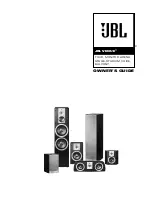
533-00-022-9D
URL: http://www.toa.jp/
2. HOW TO USE
2.1. Handling Precautions
• When installing the speaker, be sure the drain hole is positioned facing the ground
(SC-610, SC-615, and SC-630 series). Without the drain hole positioned correctly, rain
could flood the speaker, causing it to fail.
• Be sure to note the following polarities when multiple speakers are used in the same location. Incorrect connections
could result in no bass output or decreased volume.
Black speaker cable: Positive (+), White speaker cable: Negative (–) or COM
Connect the cables to other cables of the same colors in parallel connections, and to cables of different colors in series
connections.
• To avoid amplifier failure, do not simultaneously connect both low- and high-impedance speakers to the amplifier.
Ensure that only one type is connected.
Notes:
(1) "Low-impedance" refers to speakers having no built-in matching transformer.
(2) "High-impedance" refers to speakers having a built-in matching transformer.
• Ensure only the specified line voltage (amplifier output voltage) is used for the high-impedance speakers. The line
voltage is indicated on the name plate as either [25/70 V LINE] or [70/100 V LINE]. If an unspecified line voltage is
connected, fire or equipment failure could result.
2.2. Connections
2.2.1. Low-impedance speakers
When using two or more speakers, all connected speakers must have identical impedance and input ratings.
(1) The total speaker impedance must be equal to the amplifier output impedance. If the total speaker impedance is less
than the amplifier's output impedance, the speakers or amplifier could fail.
(2) When parallel-connecting all speakers, the total rated input of all the speakers must be greater than the amplifier output.
Note:
It is highly recommended that solid wire speaker cable with diameter of over 2 mm or strand wire of over 3.5 mm
2
be used to minimize transmission loss. When there are long distances between amplifier and speaker (30 – 50 m),
connect an optional matching transformer to convert the speakers to high-impedance operation.
2.2.2. High-impedance speakers
The total rated input of all connected speakers must be equal to or smaller than the amplifier output. If the total speaker
input rating is greater than the amplifier output, the amplifier could fail. Connect all speakers in parallel.
2.3. Impedance Selection
Select the desired impedance by inserting a screwdriver into the impedance selector switch slot and turning the switch.
The OFF position disconnects the speaker from the amplifier and no sound is output.
Notes:
(1) Speakers are factory-preset for the highest rated input of two line
voltages (i.e. 100 V line in the case of the 70/100 V line version).
(2) The speaker's rated input and impedance are indicated on the
name plate.
Speakers are designed to select either of the two line voltages (rated
amplifier output voltage). Check to confirm the line voltage to use, and
select the line voltage impedance specified on the name plate.
2.4. Assembling the Speaker
Speakers are packed in their cartons divided into the
following three parts: Bell, Center and Bracket. Assemble
these components as shown in the figure using four assembly
screws attached to the "Center."
Impedance marker
Impedance pointer
(Also function as a screwdriver slot.)
Impedance selector switch
Drain hole
Center
Do not use the impedance selector switch position marked as [–], because
this position could result in amplifier or speaker failure, or fire.
WARNING
[Front view]
Bracket
Assembly screws
Center
Bell
Applicable Speaker :
TC-615 / 615M / 630 / 630M / 631 / 631M
TH-650 / 660
Traceability Information for Europe
Manufacturer: TOA Corporation
7-2-1, Minatojima-Nakamachi, Chuo-ku, Kobe, Hyogo,
Japan
Authorized representative: TOA Electronics Europe GmbH
Suederstrasse 282, 20537 Hamburg,
Germany




















